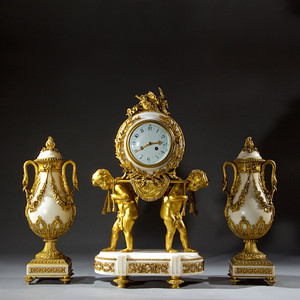
A fine antique French Gilt bronze and white marble garniture set of three putti playing in Thor's chariot. Rendered in crisp and bronze, a pair of Rams in dynamic poses pull the chariot, which we know belongs to Thor, as he is depicted and known for his goat drawn chariot in Norse mythology. Sat upon the clockface, the entire composition is crowned by a Putto holding a ribboned sceptre of wheat, wrapped in a a lions skin. The clockface itself contains both with Roman and Arabic numerals on the dial and a Samuel Marti, 1900 medallion stamp on the back. The marble base is ornamented with an applied grapevine and acanthus scroll form ornamentation, set on paw feet. Accompanied by a pair of five-light candelabras designed after vases filled with fresh cut flowers, the garniture is cast in form of roses set in white marble urns with applied satyr mask handles and swag, with the same base ornamentation as the clock; acanthus and grapevine, and set on paw feet.
Samuel Augustus Marti was born on in 1811 in Langenthal, Canton Bern, Switzerland. Rising to become a renowned clockmaker in Paris in the second half of the 1800s, Marti established his business in 1841 in Montbéliard Doubs, an area in the northeast of France, and the birthplace of many of the most prestigious clockmakers.Marti exhibited his clocks regularly at expositions in Paris, where he won a Mention of Honour in 1839, later achieving several Gold Medals in 1841, 1851, 1852 and 1900.
The Louis XVI style is characterized by a yearning to return to antiquity. Greatly influenced by the first ever large scale archaeological excavations ever done, Pompeii in 1748 and the Herculaneum in 1738, ancient arts and design became the predominant stylistic influence of artistic production until the late 19th century. Pastoral and rustic motifs such as wreaths of roses, baskets, palmettes, small farm animals, bows and ribbons inspired by the “taste for Nature”, sheaves of wheat mixed with meadow flowers, and even some gardening tools, were mingled with the ancient mediterranean motifs such as trophies, friezes, stylized acanthus leaves, fluting, and fruit garlands, in the Louis XVI style.
Materials/ Techniques: White marble, Gilt Bronze, Enamel
Date: 1900
Dimensions:
Clock 19"h x 25"w x 8.5"d;
garniture 22"h x 13"w x 11"d























